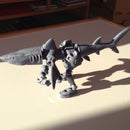Introduction: Make Your Own 3D Printed Chinese Space Ship and Station
The Chinese space program has been very active recently, with a remote controlled Moon landing mission (Chang'e and Yutu) in December, and the launch of a manned space capsule (Shenzhou) and space station (Tiangong 1) last year.
This Instructable will show you to 3D print and assemble your very own Shenzhou capsule and Tiangong space station, all held together with pin connectors so you can detach the various components and simulate the mission.
You will need:
- A 3D printer (Makerbot or similar). The largest pieces are the solar panels, almost 8 inches long.
- Plastic for your printer - ideally white and grey, optionally also black, blue, and green
- Glue for plastic - either acrylic cement or cyanoacrylate (Krazy Glue)
- Red electrical tape
- Gold or yellow permanent marker
Step 1: Download the Parts From 123Dapp.com
All the 3D models you need are on Thingiverse:
Here is the Shenzhou space capsule: https://www.thingiverse.com/thing:2763190
And the Tiangong space station: https://www.thingiverse.com/thing:2763185
They've all been split into front and back halves to make them easier to print.
Step 2: Print All the Parts
You will need to print all the parts. (Stay tuned for Makerbot-ready .thing files, but in the meantime use the instructions below.)
If you want to make the Shenzhou + Tiangong combo, make sure to print the Shenzhou Orbital Module with Dock. If not, just print the regular Orbital Module. (You can print both and swap them back and forth!)
Here is how I went about printing everything.
- The hull parts for the Tiangong station should be oriented with a flat side down, and printed in white plastic with support material enabled.
- The parts for the Shenzhou station require a bit of pre-processing:
- I cut the orbital module, re-entry module and service module in two pieces each, so they each have a flat surface, and can be printed more easily.
- Print the orbital module and service module parts in white, with support (extra bonus - print the rear section of the service module in blue, two of the missions flew in this scheme)
- Print the re-rentry module in grey, with support (extra bonus - print the re-entry module in olive green)
- Print the solar panels in black, without support. I printed them on edge, with helper disks to help them stick to the platform, and a small wedge shape to hold up the connector. (See the picture.) Printing these with support enabled is troublesome, since all the little cells will be filled with support material that is difficult to remove. You'll need 2 each of the small array & large array from Shenzhou, and 2 each of the Tiangong arrays.
- Print the 15mm pins, you'll need 12 of them.
- Optionally, there is a folded version of each of the solar panels. You can print 2 of each.
Once printed, you'll need to carefully remove any support material. Pay special attention to the sockets where the assembly pins will go, on the Shenzhou orbital and service modules, and the Tiangong service module.
Step 3: Glue (most Of) the Parts Together
Glue all the various parts that need to be glued:
- Front and back of the Service module - the thrusters line up with the sockets for the solar panel
- Front and back of the Re-entry module
- All three segments of the Tiangong (you could use pin connectors, but these not parts that ever need to come apart)
- The alignment is as follows: The radar antenna on the Tiangong service module will end up on the opposite side as the cameras (the two cylinders that stick out of the bottom science module).
- The gridded panels on the top science module are on the same side as the radar antenna
- DO NOT glue the parts of the Orbital Module yet!
Step 4: Fit the Space Station Solar Panels
You'll want to get a pair of the 15mm assembly pins, and insert them into the sockets in the side of the space station service module.
Insert them in the orientation shown - the idea is that flat sides of the pin should be parallel to the printed filament, this places the least stress on the filament layers while the pin is being inserted.
Add the solar panels, using the same principle. The connector on the solar panels is likeliest to delaminate, so be careful while inserting the pin.
When correctly fitted, the pins will snap into place, and clearance between the solar panels and the hull should be minimal.
Step 5: Assembling the Orbital Module
Here's where we assemble the two parts of the orbital module. Since the docking connector fits only one way with the Tiangong module, we want to be able to adjust the alignment to make sure the solar panels are correctly placed.
Place a 15mm assembly pin into each solar panel socket on the orbital module, and mount a small solar array on each one.
Place the orbital module (front) piece in place on the Tiangong station. You'll see that the "petals" of the docking connectors fit together.
Put some glue on the flat surface of the orbital module (back), the piece with the solar panels, and mount it on top of the orbital module (front) in place on the Tiangong station. Looking at it from the top, make sure the solar panels are aligned. The hatch (oval recess) on the Shenzhou orbital module is on the same side as the radio antenna on Tiangong.
Step 6: Putting It All Together
Let the glue dry for a bit (go get a nice snack, maybe) and then assemble the whole thing.
Put a 15mm peg in the Shenzhou service module (this one won't go anywhere, so you can glue it if you want).
Put the large solar panels into the Shenzhou service module.
Snap the re-rentry module into place on top.
Put a 15mm peg in the Shenzhou re-rentry module.
Attach the orbital module.
Put a 15mm peg into the Tiangong science module or the Shenzhou orbital module, and dock them together.
You should now have a very large model of the Chinese space capsule and space station!
Step 7: Adding Flags
The Chinese flag on these vehicles is a noticeable feature, so we should add it. Use a large piece of red tape, maybe 1" by 1.5" to make the flag for Tiangong, and a smaller piece (maybe half that) for the Shenzhou re-entry module.
I used a gold Sharpie marker to add the stars to the flag.
You could use silver paint or nail polish to highlight windows on the various modules if you wish.
Step 8: What's Next?
So you've got the model, now what?
It's a great educational tool. You can use it to demonstrate the entire mission profile. If you've printed the folded versions of the solar panels you can illustrate the launch configuration too.
Here's an outline of the mission profile:
- The Tiangong is launched first, and it deploys its solar panels. Then the Shenzhou is launched, it makes its way to orbit, deploys solar panels, and connects to the space station.
- When the mission is over, the Shenzhou orbital module can remain attached to Tiangong, or detaches with the Shenzhou capsule. The service module engines are used to de-orbit the vehicle, and the re-entry module detaches from the orbital and service modules before re-rentry.
- When the Shenzhou flies alone, the orbital module can be left in orbit for months at a time.
Other things you can do:
- The models are fully editable in 123D Design (online, mobile and desktop), so you can explore different variations. You can already download versions of the orbital module with and without the dock, but look at the attached image for a version with two reconnaissance cameras (in the middle).
- The orbital module with dock shouldn't have solar panels - fix this!
- Try exploring other things to attach instead of the solar panels - maybe a robot arm? The pin connectors are compatible with these http://www.thingiverse.com/thing:33790 so you can easily create accessories in 123D or other programs.
- Make the radio antennas detachable / movable
- Create other modules as per http://en.wikipedia.org/wiki/Tiangong_program - or your imagination!













